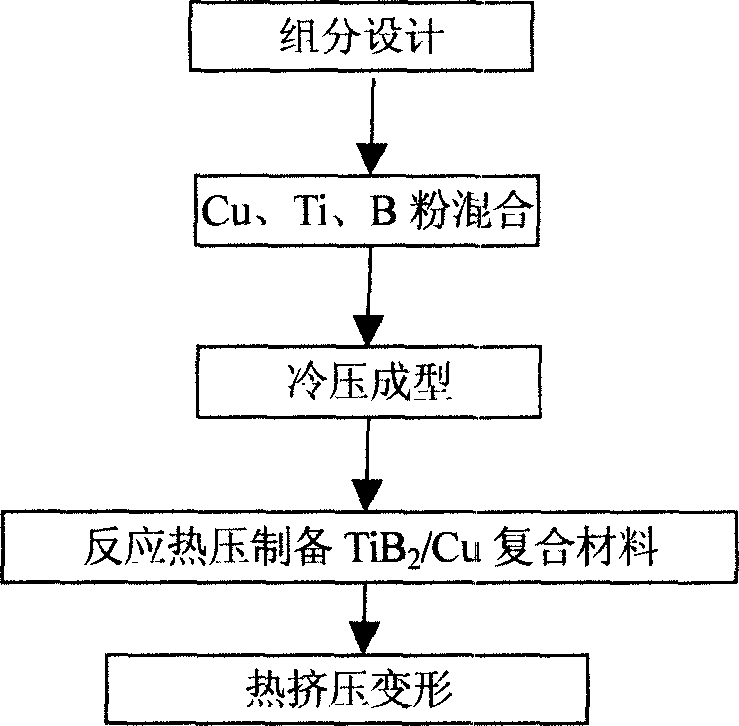Method for preparing reactive hot-press in-situ autogenesis copper-base composite material
A copper-based composite material, in-situ self-generated technology, applied in the field of preparation of copper-based composite materials, can solve the problems of complex operation, difficult control, expensive equipment, etc.
- Summary
- Abstract
- Description
- Claims
- Application Information
AI Technical Summary
Problems solved by technology
Method used
Image
Examples
specific Embodiment approach 1
[0008] Specific embodiment one: this embodiment is carried out according to the following steps: a, ball milling method powder mixing: put the prepared Ti powder, B powder and Cu powder into the ball mill tank, first vacuumize, then fill with argon to prevent ball milling The powder is oxidized during the process, and the TiB 2 In the preparation process of Cu / Cu composite materials, the ball milling process parameters are very important for the successful preparation of composite materials. If the ball milling speed is too low, the ball material ratio is small or the powder mixing time is too short, it will easily lead to uneven powder mixing; on the contrary, if If the ball milling speed is too high, the ball-to-material ratio is too large, or the powder mixing time is too long, mechanical alloying will occur (that is, a chemical reaction has occurred during the ball milling process to form a composite material), and mechanical alloying is easy to introduce into the ball mill...
specific Embodiment approach 2
[0009] Specific Embodiment 2: The difference between this embodiment and Specific Embodiment 1 is that in order to further improve TiB 2 / Cu composite material structure, to improve the performance of the composite material, the composite material prepared by reactive hot pressing must be hot-extruded: the composite material is covered with low-carbon steel, the composite material is heated to 900-1000 °C, and the extrusion die is simultaneously Heating to 480-540°C, then taking the composite material out of the heating furnace and putting it into an extrusion die, and hot-extruding the composite material to obtain high-quality TiB 2 / Cu composite material. The extrusion ratio is 20-30:1, and the cone angle of the die is 120°.
specific Embodiment approach 3
[0010] Specific implementation mode three: this implementation mode is realized in this way:
[0011] a. Powder mixing by ball milling method: put the prepared Ti powder, B powder and Cu powder into the ball mill tank, first vacuumize, and then fill with argon to prevent the powder from being oxidized during the ball milling process. The powder is mixed on a planetary ball mill, the ball-to-material ratio is 5:1, the rotating speed is 300 rpm, and the powder mixing time is 8 hours.
[0012] b. Cold pressing molding: Put the mixed powder into graphite mold and cold pressing molding, the material density reaches 30%.
[0013] c. Hot press sintering: Then put the powder together with the graphite mold into a vacuum hot press furnace for hot press sintering. First evacuate to a vacuum of 10 -3 Torr, then start heating at a heating rate of 10°C / min, heat to 650°C for 30 minutes, degas, and press the material to a density of 80%. Continue heating to 950°C, press the material unti...
PUM
| Property | Measurement | Unit |
|---|---|---|
| size | aaaaa | aaaaa |
| size | aaaaa | aaaaa |
| melting point | aaaaa | aaaaa |
Abstract
Description
Claims
Application Information
 Login to View More
Login to View More - R&D
- Intellectual Property
- Life Sciences
- Materials
- Tech Scout
- Unparalleled Data Quality
- Higher Quality Content
- 60% Fewer Hallucinations
Browse by: Latest US Patents, China's latest patents, Technical Efficacy Thesaurus, Application Domain, Technology Topic, Popular Technical Reports.
© 2025 PatSnap. All rights reserved.Legal|Privacy policy|Modern Slavery Act Transparency Statement|Sitemap|About US| Contact US: help@patsnap.com

